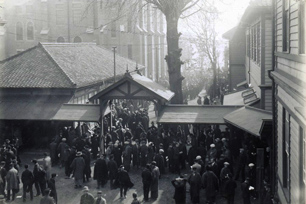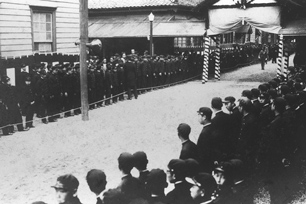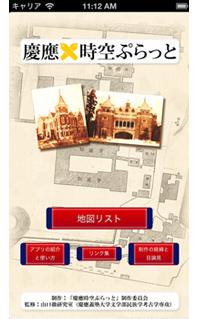Toru Yamaguchi, Professor, Faculty of Letters (Archaeology and Ethnology, Department of Humanities and Social Science)
“Keio Plat of Time and Space ”, an App for “Doing Histories”

(Fukuzawa Memorial Center for Modern Japanese Studies collection)

Places have the power to evoke memories. The more traces, the stronger. Even if it is not your own experience, when you find a glimpse of something recognizable in an old photograph, past events suddenly start to seem familiar.
The photo of the entrance exams in 1928 (photo 1) is filled with students who have come to take the exams wearing thick cloaks, or haori coats. The scene is surrounded by unfamiliar wooden school buildings, but since we can recognize the Jukukan-kyoku (Keio Corporate Administration), we can see that the leafless gingko tree in the photo is the large gingko tree in the Mita Quad. Four years later in 1932, Prince Chichibu visited Keio University on the occasion of Keio’s 75th Anniversary Commemorative Ceremony. In a photo from that day (photo 2), we can see Keio Yochisha Elementary School students lined up to welcome the prince as he walks past the wooden school buildings, heading for the Grand Lecture Hall where the ceremony took place. From the shape of the roof of the open corridor that connects the two buildings, we can see that the passage where the students are lined up is the same passage seen in the previous photo of the entrance exams. We can assume that in photo 2, the prince is about to walk past the large gingko tree.

People’s memories and vestiges of events accumulate in places. We wanted people to become more aware that history is layered, so we developed a free smartphone application named “Keio Plat of time and space” in which we show old photos of the campus situated in time and space. We have been fortunate that this app has more than 1,300 downloads to date. The idea of developing this app came up while far from home conducting research in the South Pacific. I was excavating in a coral island, and the islanders would come and peer down on me. They looked perplexed at the accumulated cultural layers and what kind of meanings they could have. That was when I truly felt that I wanted to become an agent who helps bring forgotten memories of the past back to the present.
When I used this app during class, students started to weave their own Keio history using the old photos. This was indeed an unexpected effect of the app in that it allows the users to experience the process of “doing histories.” Presenting histories in plural form should become some kind of force to act against a biased tendency to converge on a singular version or aspect of history. As such, the work of archaeologists and historians are both old and new.
*Both iOS and Android versions are available.
Please search for “慶應時空ぷらっと” (Please type in hiragana/Japanese “keiou jikuu puratto”) in the app download service for your device.
*Position titles, etc., are those at the time of publishing.
